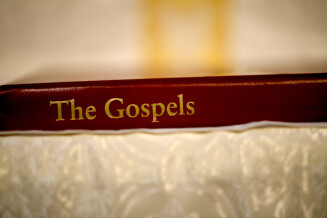Quasquicentennial Q&A: Who We Are Now - St. Matthias

Editor's note: This is the 125th anniversary of the Episcopal Diocese of Dallas. Below is a Q&A answered by members of our churches reflecting on who we are now.
Church name: St. Matthias
Location: Athens, Texas
Rite I or Rite II: Rite I
Average Sunday Attendance: 41
Special Annual Events at the Church: Smorgasbord, Brotherhood Auction, Fall Cocktail Party, Lessons and Carols
Musical Styling: Tranditional, 1940 and 1982 Hymnals
How many weekly services? Four. Sunday: Morning Prayer & Mass, Wednesday: Mass n’ Class, Thursday: Mass n’ Class
When did this church start? 1947
Favorite ministry? We’re small so our whole church is one big ministry!
What do want people to know about your church?
The story of St. Matthias Episcopal Church in Athens, Texas, begins in 1946, just after World War II when, according to an article in the Athens Review, a daughter of a local family expressed the desire to be confirmed in the Episcopal church. Since there was no such church in Athens, a local minister wondered if others might also be interested. The first service was held February 24, that year. In the church calendar this date is the feast of St. Matthias the Apostle, and so the new church was given his name. From that meeting with the help of the Rt. Rev C. Avery Mason, Bishop of the Diocese of Dallas, and the Rev. R.O. Kennaugh, rector of St. John’s church in Corsicana, the Episcopal Church came to Athens to offer the people the beauty, strength, and joy of the faith and practice of the historic church.
Then in the spring of 1947 the St. Matthias community acquired their own building when a structure that had started as a military chapel from Camp Fannin in Tyler was relocated to Athens. It was placed on property at the corner of Loyola and Mission streets and the church was dedicated and the cornerstone laid by Bishop Mason June 15, 1947. Later a parish hall and rectory (priest’s residence) were added.
In the early 1970’s the building on Mission at Loyola was sold to a Baptist congregation and St. Matthias began construction of their present building, while the congregation temporarily worshipped at the First Methodist church. The first service in the not-quite finished new building was a Christmas Eve Midnight Mass in 1972. The education building was constructed and dedicated to the glory of God in 1993. It contains St. Mary’s Chapel, the parish office, priest’s office, library, meeting room, nursery and Sunday School.
The pilgrimage of the church bell to it’s rightful home is a story in it’s own right. It began when St. Matthias moved to the present location, leaving the bell with the building sold to the Baptist church. However, when the Baptist church later sold the building the bell was removed and lodged in the barn of a member of that church. 40 some-odd years later the bell was located it was removed from the barn and returned to the St. Matthias church to be housed in a new tower.
In 2019 the Church was completely remodeled through the generosity of the Episcopal Foundation of Dallas, and through memorials to long time member Bob Gould. A new porcelain tile floor though out replacing worn and disintegrating carpeting, and a new more functional and attractive arrangement of the chancel were the primary improvements. Additionally the chancel furnishings were refinished so that for the first time in the history of the church all of the fittings matched! In 2020 through the grace of God St. Matthias was able to obtain a certified relic of our Patron saint, the Apostle Matthias himself. Additionally the high altar contains relics of St. Clement of Rome and St. Victorian, and the Lady Chapel altar contains relics of St. Amand and St. Lucent.
So it was, that while over these many years St. Matthias Episcopal Church has occupied at least two locations, and with and without a bell, but always offering Orthodox teaching, traditional Anglican worship in the Catholic tradition, and striving to play an important role in the lives of the church members, and the Athens community.

